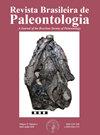Evolution of the Semideciduous-Riparian Forest (ecotone Cerrado-Atlantic Forest) during the late Holocene, Southeast of Brazil
IF 0.6
4区 地球科学
Q4 PALEONTOLOGY
引用次数: 0
Abstract
The floodplains of meandering rivers in southeastern Brazil represent places where the sedimentary record associated with the history of transition/ecotone areas and exchange of biomes accumulates, such as the Cerrado (Cerradão Forest) and Atlantic Forest (Semideciduous-Riparian Forest). The present study aims to use palynological, isotopic (δ13C, δ15N and 14C), and anthracological indicators in cores taken from three abandoned meander bends to make inferences about environmental evolution, vegetation reconstruction, and climatic inferences. The study area is located in the Mogi Guaçu River Basin, in the countryside of São Paulo State. The studies show that ~2,730 BP (stage I), the area underwent through a more humid climatic phase compared to the current one, which allowed the expansion of the Riparian Semideciduous Forest. After that date, in stage II (1,800 to 510 BP), the percentage of the Cerrado (Cerradão Forest) increased, due to a drier period. From 510 BP to the present day (stage III), humidity has taken place with a new expansion of the Riparian Semideciduous Forest, although elements of Cerrado are present. Microscopic charcoal fragments were found in all stages and may infer the incidence of paleo-wildfires during the Late Holocene. The results indicate that both phytophysiognomies remained for the studied period, varying their expansion depending on the humidity present in each stage. Although lakes formed by abandoned meanders are not areas with the best palynological record, they are frequent environments in the interior of the continents. If properly interpreted, they may provide relevant information to vegetation and climatic changes for the areas. Keywords: paleoenvironmental studies, Holocene, river dynamics, pollen grains, isotopic analysis, charcoal fragments.巴西东南部全新世晚期半落叶河岸林(过渡带塞拉多-大西洋林)的演变
巴西东南部蜿蜒河流的泛滥平原代表了与过渡/交错带历史和生物群落交换相关的沉积记录积累的地方,如塞拉多(塞拉多森林)和大西洋森林(半落叶河岸森林)。本研究旨在利用三个废弃曲流弯道岩芯中的孢粉学、同位素(δ13C、δ15N和14C)和炭疽学指标,对环境演变、植被重建和气候推断进行推断。研究区域位于圣保罗州农村的Mogi Guaçu河流域。研究表明,与目前相比,该地区经历了一个更潮湿的气候阶段,约2730 BP(第一阶段),这使得河岸半落叶林得以扩张。此后,在第二阶段(1800至510 BP),由于干旱期,塞拉多森林的百分比有所增加。从510 BP到今天(第三阶段),尽管存在塞拉多元素,但随着河岸半落叶林的新扩张,湿度也发生了变化。在所有阶段都发现了微观木炭碎片,这可能推断出全新世晚期古野火的发生率。结果表明,这两种植物相学在研究期间都保持不变,其扩展程度取决于每个阶段的湿度。虽然由废弃的曲流形成的湖泊不是有最好的孢粉记录的地区,但它们是大陆内部的常见环境。如果解释得当,它们可以为该地区的植被和气候变化提供相关信息。关键词:古环境研究,全新世,河流动力学,花粉粒,同位素分析,木炭碎片。
本文章由计算机程序翻译,如有差异,请以英文原文为准。
求助全文
约1分钟内获得全文
求助全文
来源期刊

Revista Brasileira De Paleontologia
PALEONTOLOGY-
CiteScore
1.60
自引率
14.30%
发文量
25
审稿时长
>12 weeks
期刊介绍:
It publishes original contributions on all aspects of Paleontology. Papers are written in English, Spanish, or Portuguese and are reviewed by international experts.
 求助内容:
求助内容: 应助结果提醒方式:
应助结果提醒方式:


